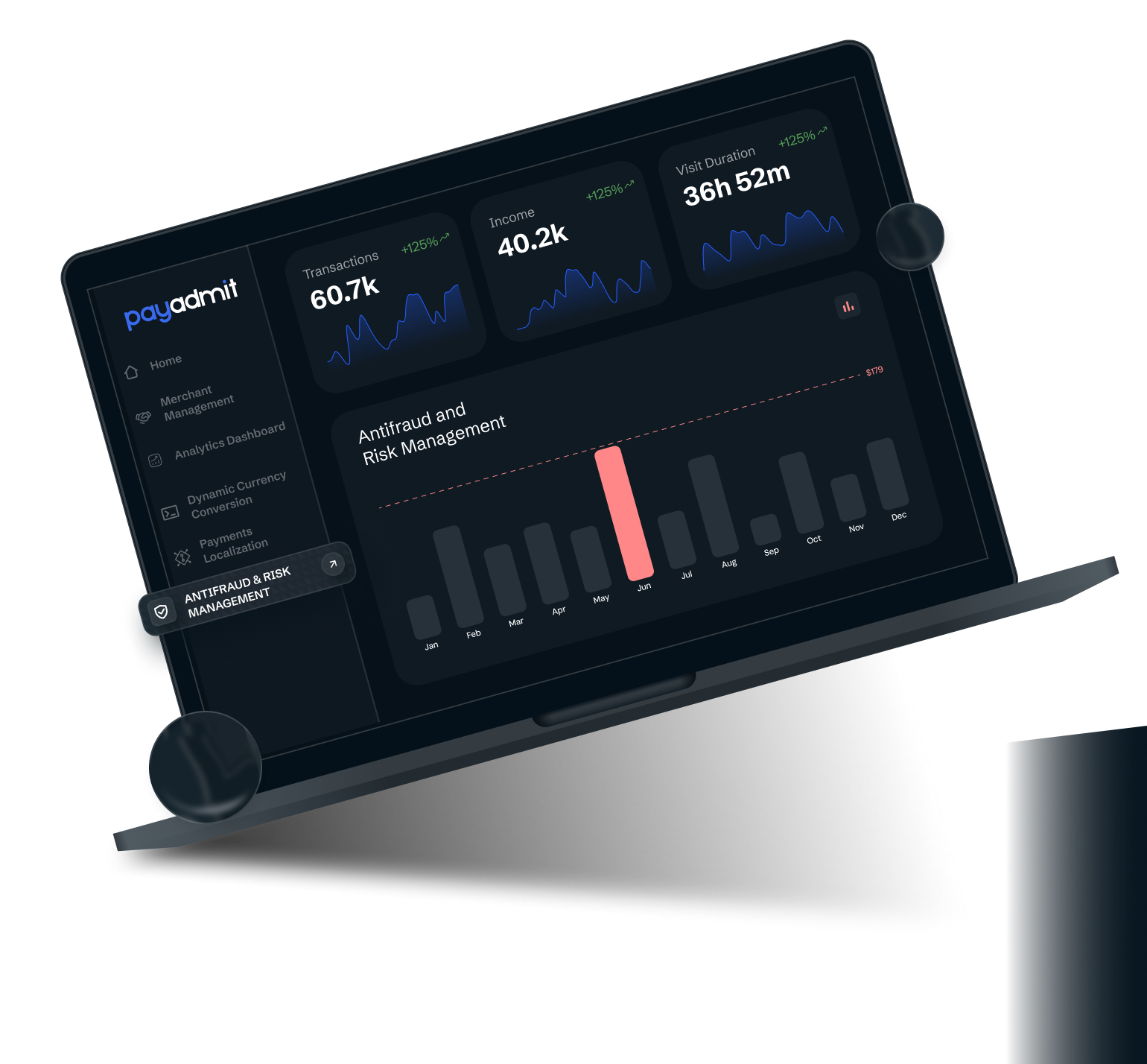An antifraud system is a tool that detects and prevents fraud in digital transactions. It uses real-time monitoring, machine learning, and behavioral analysis to identify suspicious activities. This system can help businesses reduce financial losses, protect customer data, and ensure compliance with security regulations like AML and PCI-DSS.
WHAT IS FRAUD AND RISK MANAGEMENT IN DIGITAL PAYMENTS?
A fraud and risk management aims to detect, prevent, and respond to unauthorized or suspicious payments. An effective antifraud solution can create a safe digital payment environment for commercial companies and customers. Are there any risks? Your company will be able to prevent those risks on time and maintain public trust.
At PayAdmit, we offer a payment fraud detection system with a large number of settings, which can be adjusted to your business needs. If the fraud control detects a suspicious payment, it automatically rejects it and sends you a notification.
Use anti-fraud mechanisms to respond to the changing risk environment efficiently.
BENEFITS OF PAYADMIT PAYMENT RISK MANAGEMENT
At PayAdmit, we have an antifraud payment software that protects digital transactions from potential risks. Using our service, you get several key benefits:
Minimum chargeback level. We reduce the payment risk while helping you avoid financial and reputational losses.
Personalization. We offer extensive settings to be adjusted to your business needs.
Extensive filters. We use over 100 adjustable filters to analyze your digital transactions.
Cost reduction. We help you minimize your operational costs due to automatic risk assessment.
Data storage. We store all information about fraudulent activities and transactions that were rejected by the antifraud system.
User trust. We help you increase the level of user loyalty through maximum protection.
Build enhanced resilience to protect your business from payment fraud risk.
WHY CHOOSE TRANSACTION RISK MANAGEMENT SOLUTIONS FROM PAYADMIT?
We help businesses block fraudulent signups, detect payment fraud, reduce chargebacks, and prevent other abuse using a professional antifraud system. We also assist you with building fraud control policies and response plans, which allow you to manage potential payment threats effectively.
When businesses complete multiple transactions per minute, fraud prevention becomes a central part of their success. Learn the critical elements of fraud risk management and how it helps your company identify vulnerabilities, mitigate financial losses, and maintain trust in today’s market.
Let your business grow safely by preventing and detecting fraud early on.
FREQUENTLY ASKED QUESTIONS
What is an antifraud system?

How does an antifraud system work?

It monitors digital transactions and customer behavior in real time, comparing data against familiar fraud patterns. Once it detects suspicious activity, it blocks threats and protects future digital payments from similar issues.
What is risk management?

Risk management aims to detect, assess, and reduce potential threats to digital payments. It helps commercial companies ensure regulatory compliance, prevent financial losses, and maintain a positive reputation.
What are the main types of digital payment fraud?

The main types of digital payment fraud include phone scams, fake websites, online phishing, unauthorized transfers to fake accounts, and card fraud from lost or stolen cards.
How do you recognize a fraudulent payment?

Red flags include fake contact details, inconsistent customer information, unusual communication, declined transactions, and abnormally large orders. These indicate suspicious activity and require immediate investigation using fraud detection tools and manual review.
What are the most common antifraud challenges?

These include the constant need to refresh detection mechanisms, the risk of inaccurate data integration, cross-border complications, and resource limitations.
Are there any other ways to mitigate the risk of fraud in digital payments?

Yes, businesses can reduce fraud risks by using secure payment gateways, regular security audits, and staff training. Monitoring chargebacks, updating software, and implementing strict KYC/AML procedures also help prevent illicit activities in digital transactions.
What risks does payment fraud have to your business?

Payment fraud can lead to financial losses, lost customer trust, and reputational damage. It may also bring consequences for non-compliance with regulations. Over time, frequent scams can reduce customer loyalty, impact revenues, and increase operational costs due to fraud prevention and investigation efforts.
